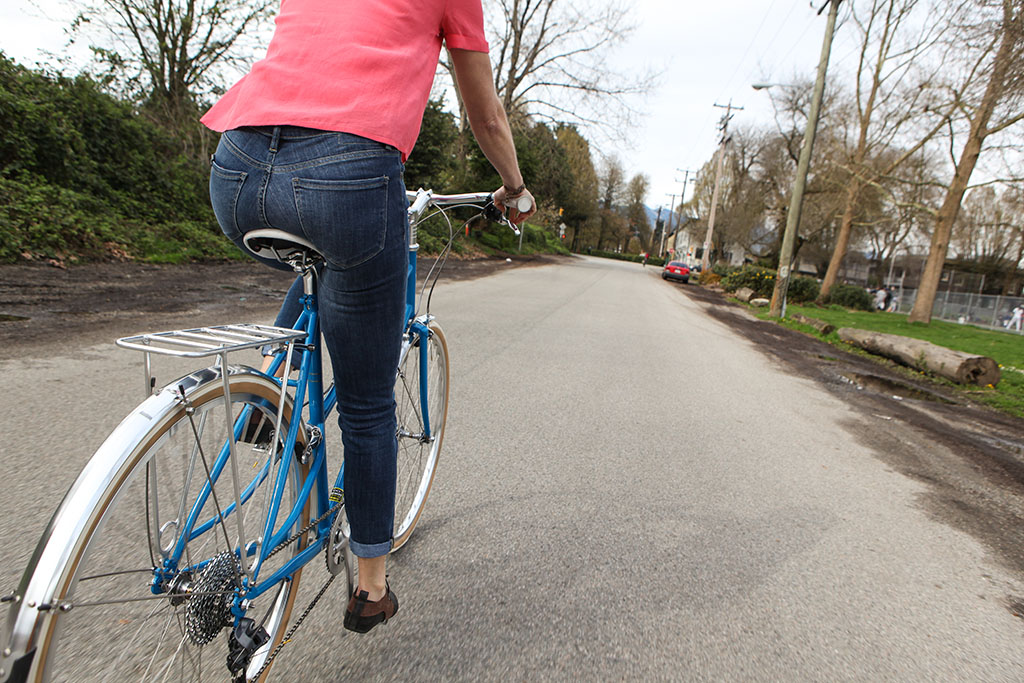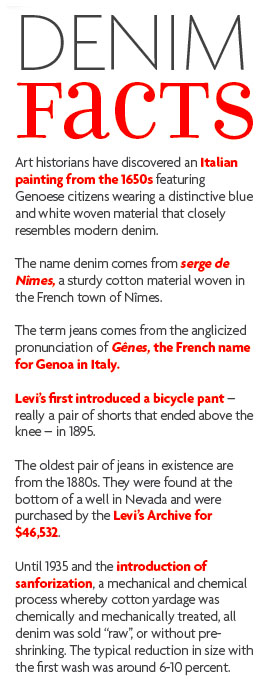Autumn Gear Guide
Find inspiration in our Gear Guide that will keep you out on your bike through wind or rain.
Download NowHow high-tech fabrics have reinvented this everyday fashion staple.

Tracey is wearing Dish performance denim Skinny Dark Stone jeans. Photo by David Niddrie.
Perhaps you don’t wear them at all. You may have given up on them years ago when you found that the twill weave cotton was tough and yet delicate at the same time, strangling your quads while wearing out against your saddle. Classic jeans can be particularly ill-suited for everyday biking.
“I never found regular jeans comfortable and hadn’t owned a pair of jeans for at least a decade,” said Sean Carter, owner of Calgary, AB’s, Bike Bike Inc. “Basically, the trouble I had with jeans in general was they would fit too tight around my hip flexor area, which made cycling on any bike (I own many upright and sporty bikes) restrictive and uncomfortable, sometimes to the point of cramping.”

At the construction level, jeans are cut closer to the body and with a tighter fit than almost any other type of pant not specifically designed for athletic activity. Not only are they not designed with movement in mind; they actually restrict the range of motion of the legs. Why then would we still want jeans if comfort and mobility were ultimately sacrificed?
Like the bicycle is to urban transportation, blue jeans are an incredibly efficient way of crossing sartorial space. They can be dressed up with a sport coat or heels. They can be dressed down with a perfectly aged band T-shirt. In an odd trick of convention, they can be worn with any other hue or shade, even other shades of denim. The irony is that when the metaphorical bicycle of fashion meets the actual bicycle, the experience can be quite uncomfortable.
Looking back through the history of denim we find a long-running desire for better functionality and durability. Before World War II, jeans were worn almost exclusively in the American West. Miners, farm workers, and ranchers relied on the durable cotton to weather their hard work. The breaking-in period was long and included a soak in a horse trough followed by wearing the wet jeans until they dried. This achieved a shrink-to-fit shape, a type of DIY tailoring from the Old West.
Fortunately, there are an increasing number of talented designers devoted to making jeans that pose no barrier to mobility. The emerging cycling denim industry has been elevated by innovations in high-tech textiles that resemble their traditional counterparts. “Technology is driving this trend forward,” said Amy Leverton, jeans expert and author of Denim Dudes. “There are some very smart fabrics out there: ridiculously lightweight and super stretch denims, ultra durable strength fabrics, moisture wicking technologies, etc. People want classic silhouettes and detailing, but they want to feel the difference.” Leverton goes on to note that bike jeans are a “strong trend in jeanswear at the moment. People are looking for more out of their denim”.
According to JeWon Yu, the designer who spearheaded Levi’s Commuter line, “The four must-haves of cycle jeans are: back rise, stretch, reflectivity, and reinforcement of key areas.” Levi’s introduced the Commuter line for men in 2011, on the heels of niche brands like Cadence and Osloh. While the women’s Commuter range from Levi’s was released earlier this year, women keenly felt the delay. Recognizing the opportunity, San Francisco-based Betabrand began selling their women’s Bike to Work jeans in 2012, following the successful launch of their men’s Bike to Work Line in 2011. Betabrand womenswear designer Tony Wloch has been tracking down just the right blue jean material. He notes that the womenswear customer is a lot more discerning, particularly when it come to the material with which her jeans are made. To that end, Wloch has been working closely with a manufacturer to “develop the perfect quality of denim that will perform the way we want it to and hold up to our longevity standards”.
Betabrand isn’t alone in the search for comfort, mobility, and durability in a pair of jeans. In fact, if you look beyond what big brands like Levi’s are doing, there are a lot of labels developing denim for urban cycling. Swrve has built an extremely loyal following with their unique blend of durable Cordura jeans. Richard Masoner, of the influential blog Cyclelicious, said, “I’m on my third pair of Swrve jeans now. I love them.”
Steven Sal Debus, a designer at DU/ ER and Dish Performance Denim and bike polo player, claimed that his company’s jeans are even better than Levi’s. “I own five pairs of Levi’s Commuter jeans and our jeans are way more comfortable and stretchy, plus ours fit a cyclist with real cyclist legs and butts!” said Sal Debus. Dish has focused on using some of the most technically advanced and high performing denim available in their women’s line. “With 28 percent Coolmax in our L2X denim you get quick-dry temperature-control fabric that has more hold and memory than any jean on the market,” said Sal Debus. “We also made our jeans lighter so they are inherently more breathable than regular jeans. No baggy knees or saggy bums after your bike ride.” At the same time, the company eschews a technical look. The denim collection features classically sexy jean silhouettes that wouldn’t be out of place in Los Angeles, the premium denim capital of the world. “Yes, we want people to know and look like they are wearing jeans so they can wear them to meetings, work, and out at night too. We want people to look stylish no matter what they are doing.”
Melissa Davies is a lifelong cyclist, fashion designer, and co-founder of Bike Pretty, an online store for fashionable bike-ists. bikepretty.com | @bikepretty
Find inspiration in our Gear Guide that will keep you out on your bike through wind or rain.
Download Now
Too bad RYB Denim cycling jeans weren’t included in this, as the owner is still progressing adding more products and colours to the line. 5 years+ in the making, starting with women first, they are expanding into unisex and mens in the near future. Might want to see how their story has been going given the competitors starting and stopping their commitment to women’s fit denim apparel products *ahem Levi’s*
After reading “Everything you need to know about cycling jeans” I know virtually nothing about the garment. I know a lot about history, but nothing about the garment. I assume they do not include any sort of chamois. I am guessing there are still the usual seams running right down the center of my prostate. But I don’t know.
Is this a hipster thing or a function thing ? Still don’t know
Marketing Position
Love ❤ the feminine denim cycle jeans ?!! Could purchase,my own!! Love the fashion of cycling bloomers,Thank you!!
I’m sorry why are you even talking about Swrve, who won’t make jeans for women? When I asked them about it they just suggested I go elsewhere. And the Levi’s line is definitely too little, too late, with still far less choices than the men’s line and the reviews of the products are abysmal in terms of fit and functionality. Also, I love the massive amount of quotes from men on this article that is supposed to be focused on women’s cycling jeans (because on the homepage this article is categorized as “women”)? Nothing against men at all, I just think that the lack of cycling apparel for women is a real problem. It seems like every day I hear about some great new company (ex: Osloh, or Outlier cut their women’s line by massive amount) making cycling-specific clothing and they never have any items for women. It seems like Rapha and Vulpine, both in the UK, are the only ones that get it, and American brands are lagging far behind. I’m just as disappointed in this article as I am with all of these clothing manufacturers.
Hi Jessica, sorry about the disappointment! This article was definitely *not* intended to be a focus on cycling jeans made for women, hence the quotes from men and the discussion of men’s and women’s apparel in the same article. Not sure why it was categorized as “women”. Perhaps because it’s written by, you know, a woman? 😉
As for Swrve specifically, they used to make a women’s bike jean but discontinued because people weren’t buying. This is not unusual. I’ve heard similar responses from other commuter clothing brands, like the ones you mention. Seems like there is a story here about the perception that commuter clothing companies are ignoring women’s apparel. Or are women ignoring the efforts of the clothing companies? Or is marketing the problem?
It’s great that people realize women cycle too and cycle in jeans. Can they start realizing that we need real pockets also? All women’s jeans have small front and rear pockets making it incredibly difficult to carry a lock, wallet, or really anything. It’s ridiculous. Thanks for the great material, but can we also remember women are practical too and just want to carry items to their destinations…just like the boys.
It’s interesting that you bring up an aspect of women’s jeans that are less than “practical”. Part of my thesis was that jeans are not practical at all. At least not for people who bike. That’s why so many high-tech textiles are used to make cycling jeans.
At this point, almost all of us (men and women) wear them for reasons of fashion and jump through all sorts of technical and stylistic hoops to make them work. It’s because the social significance of denim is more important than personal comfort or functionality.
• I’m part of Swrve’s extremely loyal following, but the Cordura jeans aren’t the reason at all. Their regular denim jeans are perfect, and are made in the U.S. instead of offshore.
Comments are closed.